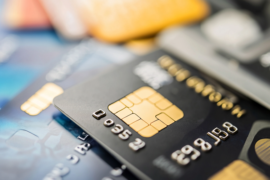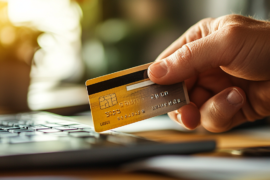This article may contain references to products or services from one or more of our advertisers or partners. We may receive compensation when you click on links to those products or services. Nonetheless, our opinions are our own.
The information presented in this article is accurate to the best of our knowledge at the time of publication. However, information is subject to change, and no guarantees are made about the continued accuracy or completeness of this content after its publication date.
- Understanding the Concept of Revolving Debt and Its Impact on Your Finances
- The Mechanics of Credit Cards and Lines of Credit Explained
- Examples of Revolving Debt
- Advantages of Revolving Debt: When It Can Work in Your Favor
- Revolving Debt vs. Installment Debt
- Strategies to Manage and Reduce Your Revolving Debt Effectively
- Taking Control: Building a Healthy Financial Future with Smart Debt Decisions
- Frequently Asked Questions
- Recommended Reads
Understanding the Concept of Revolving Debt and Its Impact on Your Finances
Revolving debt is a type of credit that allows you to borrow money repeatedly up to a set limit, paying off the balance over time while also having the ability to access additional funds as needed. Common examples include credit cards and lines of credit. This versatility can be helpful and risky; it gives you immediate access to cash when necessary, but can also lead to overspending and accumulating debt if not managed carefully. Understanding how revolving credit works is essential for managing your finances effectively and making informed decisions that impact your financial health.
When used wisely, revolving credit can enhance your financial stability. However, mismanagement can lead to challenges such as:
High-interest payments: Carrying a balance can result in significant interest charges, which can snowball over time.
Credit score impact: High utilization rates can negatively affect your credit score, making it harder to secure favorable rates on future loans.
Budgeting complications: Easy access to credit can make it tempting to spend beyond your means, complicating your budget and savings goals.
To illustrate how revolving debt can affect your finances, consider the following hypothetical scenario:
| Scenario | Balance | Monthly Payment | Interest Rate |
|---|---|---|---|
| Just Paid Off | $0 | $50 | 15% |
| Carrying $1,000 | $1,000 | $50 | 15% |
| Overspent at $5,000 | $5,000 | $200 | 15% |
Using revolving debt can create opportunities for financial gain, but it’s essential to maintain a disciplined approach. Regularly monitoring your balance and making payments on time can help you avoid the pitfalls of this flexible credit option.
The Mechanics of Credit Cards and Lines of Credit Explained
When thinking about credit cards and lines of credit, it’s essential to understand how they operate and fit into the broader category of revolving debt. Revolving credit allows you to borrow money repeatedly up to a set limit, paying interest only on the amount used. This flexibility can be an advantage, helping you manage cash flow and unexpected expenses. However, using this feature wisely is crucial to avoid escalating debt. Key components to remember include:
Credit limit: This is the maximum amount you can borrow. Exceeding it often results in fees or declined transactions.
Minimum payment: Credit card companies usually require a minimum monthly payment. Paying only this amount can keep you in debt longer.
Interest rates: The interest rate on revolving credit can be high, so paying off your balance in full is important when possible.
Consider this table illustrating the impact of different payment strategies on your balance over time:
| Balance | Minimum Payment | Payment in Full |
|---|---|---|
| $1,000 | $25/month | Pay $1,000 |
| $1,500 | $37.50/month | Pay $1,500 |
| $2,000 | $50/month | Pay $2,000 |
Understanding these basics can help you harness the power of revolving debt to support your financial goals. It is essential to be aware of your spending habits and the long-term costs of borrowing.
Examples of Revolving Debt
Credit cards, home equity lines of credit (HELOC), and personal lines of credit are examples of revolving debt. These forms of credit allow borrowers to access funds up to a predetermined limit and repay the borrowed amount with interest. They provide flexibility and convenience in managing finances, but responsible use is necessary to avoid accumulating excessive debt and high-interest costs.
Credit cards
Credit cards are one of the most common examples of revolving debt. They provide users with a line of credit that can be borrowed and repaid continuously within a set limit. While they offer convenience, using them responsibly is essential to avoid falling into a cycle of escalating debt. Monitoring spending habits, making timely payments, and paying off the balance in full when possible can help prevent unnecessary costs.
Home equity line of credit (HELOC)
A home equity line of credit (HELOC) allows homeowners to borrow against the equity in their homes. This revolving debt option offers flexibility for expenses like renovations or large purchases. Using HELOCs wisely is essential, considering their impact on home equity and long-term financial goals. Regular payments and responsible borrowing are crucial.
Personal line of credit (PLOC)
A personal line of credit offers a set borrowing limit that can be used and repaid repeatedly, similar to credit cards and HELOCs. It’s useful for unexpected expenses or managing cash flow. Responsible use—such as timely payments and borrowing only what’s necessary—helps avoid overspending and interest buildup.
Voted "Best Overall Budgeting App" by Forbes and WSJ
Monarch Money helps you budget, track spending, set goals, and plan your financial future—all in one app.
Get 50% OFF your first year with code MONARCHVIP
Advantages of Revolving Debt: When It Can Work in Your Favor
Revolving debt can serve as a powerful financial tool when used wisely. One of its key advantages is flexibility. Unlike traditional loans, revolving credit allows you to borrow, repay, and borrow again, helping you manage cash flow effectively. This can be especially beneficial when handling emergencies or covering temporary gaps between paychecks.
Making timely payments can also help build a strong credit history. A high credit score is essential for securing better terms on future financial products. Benefits of responsible revolving debt use include:
Improved cash flow management: Helps with managing monthly expenses.
Fast access to funds: Enables quick response to financial emergencies.
Credit-building opportunity: On-time payments support your credit score.
Taking advantage of promotional offers such as 0% interest for a limited period can also help you manage purchases more efficiently and save money.
Revolving Debt vs. Installment Debt
Revolving and installment debt are common borrowing types, each with distinct features. Revolving debt offers ongoing access to a credit limit and is ideal for day-to-day or emergency expenses. In contrast, installment debt involves borrowing a fixed amount and repaying it in regular installments over a set term.
While revolving debt allows for repeated borrowing and repayment, installment debt is more structured and predictable. This clear repayment schedule can make budgeting more manageable for those who prefer fixed monthly payments.
Strategies to Manage and Reduce Your Revolving Debt Effectively
Managing and reducing revolving debt can feel overwhelming, but a few strategic steps can help you regain control. Start with a budget that outlines your income, essential expenses, and debt obligations. Understanding where your money goes each month can help you find areas to cut back and free up funds for debt repayment.
Another helpful strategy is to prioritize high-interest accounts. Focus on paying off the credit cards with the highest rates first while continuing minimum payments on others. If possible, consolidate your debts into a lower-interest loan or transfer balances to a low-rate card. Set monthly goals and track your progress. Small milestones can help maintain discipline and build momentum.
| Strategy | Description |
|---|---|
| Create a Budget | Outline your income, expenses, and debts to identify savings areas. |
| Prioritize Debts | Pay off high-interest debts first to reduce overall interest costs. |
| Consolidate Debts | Combine balances into one lower-rate loan to simplify payments. |
Recognizing the Risks of Excessive Revolving Debt and How to Avoid Them
Managing revolving debt can be difficult, especially when it feels like your balance never decreases. Overusing credit cards or lines of credit can create a cycle of borrowing that leads to high interest payments and long-term debt accumulation. Relying on minimum payments alone increases the risk of financial strain. Common risks include:
High-interest rates: Credit cards often have steep interest rates, allowing debt to grow quickly.
Impact on credit score: Maxed-out cards or missed payments can lower your credit score.
Emotional toll: The stress of high debt can cause anxiety and affect overall well-being.
To avoid these pitfalls, consider the following actions:
Create a budget: Track income and expenses to stay financially organized.
Pay more than the minimum: Reduces your balance faster and saves on interest.
Avoid unnecessary charges: Use credit cards only for essentials and avoid impulse spending.
Taking Control: Building a Healthy Financial Future with Smart Debt Decisions
Revolving debt can be both valuable and risky. While it provides flexibility and access to funds, it can also lead to financial strain if not appropriately managed. Typically used through credit cards or lines of credit, revolving debt allows repeated borrowing and repayment up to a set limit. Understanding this structure helps you make smarter financial choices. Key considerations include:
Credit utilization: Keep your usage below 30% of your credit limit to support your score.
Payment tracking: Regularly monitor your payments to avoid fees and interest spikes.
Interest rates: High rates mean unpaid balances proliferate if not addressed.
Using budgeting tools and prioritizing high-interest balances can prevent revolving debt from becoming unmanageable. Innovative management supports a more secure financial future.
Frequently Asked Questions
What is revolving debt?
Revolving debt is a type of credit that allows you to borrow up to a set limit, repay it, and borrow again as needed. This ongoing cycle continues as long as you remain within your limit. The most common example is a credit card.
How does revolving debt work?
You can spend up to your available limit when you use revolving credit. Each time you make a purchase, your available credit decreases. As you make payments and reduce the balance, the available credit increases again. Most accounts require at least a minimum monthly payment.
What are the benefits of revolving debt?
Revolving debt offers flexibility, allowing access to funds without needing to reapply for credit each time. It’s helpful for cash flow and unexpected expenses. It can also support your credit score by demonstrating good debt management when managed responsibly.
What are the risks associated with revolving debt?
One significant risk is the potential for accumulating high-interest charges if you carry a balance month to month. This can lead to debt that becomes harder to pay off. Overusing credit or missing payments can damage your credit score and financial health.
How can I manage revolving debt effectively?
To manage it wisely, stay within your budget and pay off the monthly balance if possible. Use a budget, monitor your spending, and avoid new purchases when you already have a balance. Knowing your limit and interest rate helps reduce risk and improve long-term financial outcomes.

Reviewed and edited by Albert Fang.
See a typo or want to suggest an edit/revision to the content? Use the contact us form to provide feedback.
At FangWallet, we value editorial integrity and open collaboration in curating quality content for readers to enjoy. Much appreciated for the assist.
Did you like our article and find it insightful? We encourage sharing the article link with family and friends to benefit as well - better yet, sharing on social media. Thank you for the support! 🍉
Article Title: Revolving Debt 101: Everything You Need to Know
https://fangwallet.com/2025/03/29/revolving-debt/The FangWallet Promise
FangWallet is an editorially independent resource - founded on breaking down challenging financial concepts for anyone to understand since 2014. While we adhere to editorial integrity, note that this post may contain references to products from our partners.
The FangWallet promise is always to have your best interest in mind and be transparent and honest about the financial picture.
Become an Insider

Subscribe to get a free daily budget planner printable to help get your money on track!
Make passive money the right way. No spam.
Editorial Disclaimer: The editorial content on this page is not provided by any of the companies mentioned. The opinions expressed here are the author's alone.
The content of this website is for informational purposes only and does not represent investment advice, or an offer or solicitation to buy or sell any security, investment, or product. Investors are encouraged to do their own due diligence, and, if necessary, consult professional advising before making any investment decisions. Investing involves a high degree of risk, and financial losses may occur including the potential loss of principal.
Source Citation References:
+ Inspo
There are no additional citations or references to note for this article at this time.












































